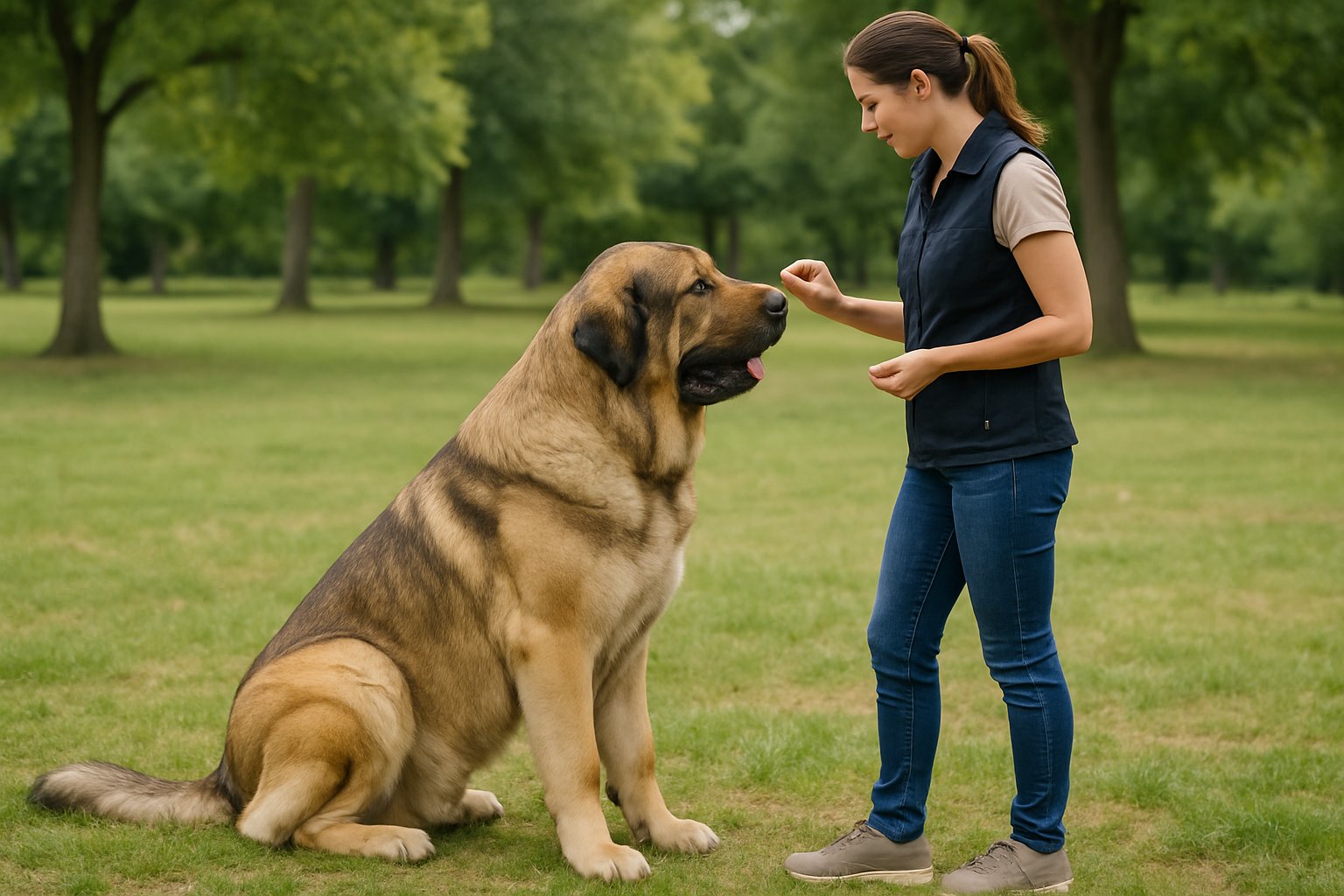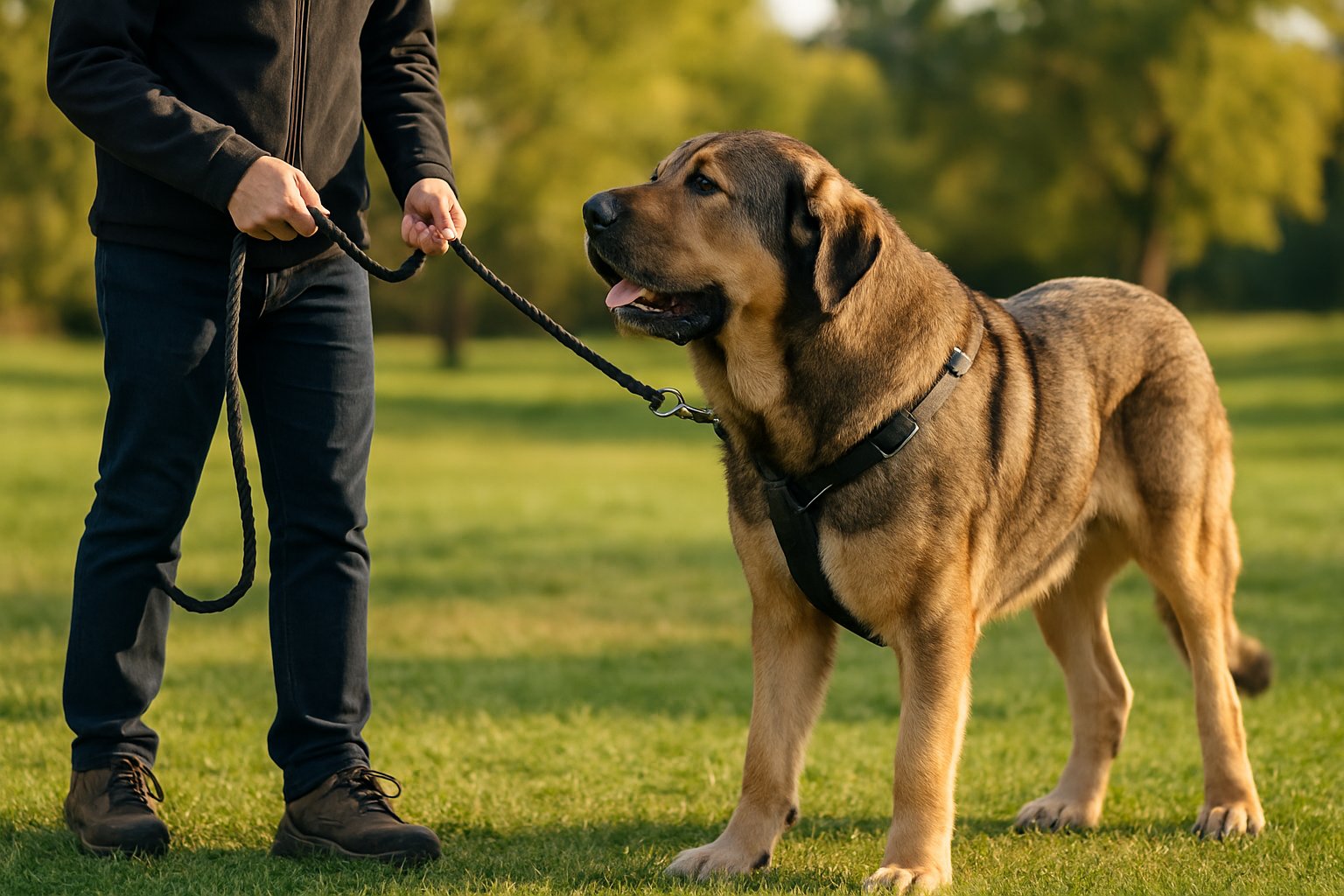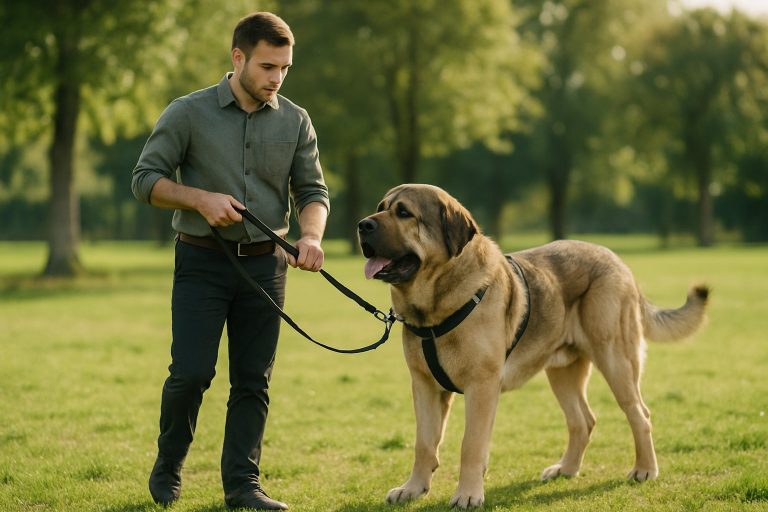Spanish Mastiffs are giant, strong dogs originally bred to protect livestock. Their natural instincts make them loyal guardians for families and homes.
Learning how to train and handle a Spanish Mastiff is important to create a calm, safe, and obedient companion. With their size, strength, and protective nature, you need the right approach to guide your dog confidently.
1. Begin socialization early to reduce territorial behavior
Start socializing your Spanish Mastiff when they are still a puppy. Early socialization helps your dog get used to new people, animals, and places. This makes it less likely for your Mastiff to be aggressive or overly territorial as they grow up. Expose your puppy to different environments, such as parks, busy streets, and quiet neighborhoods. Let them meet a variety of people and friendly dogs in controlled situations. Safe, positive encounters help your Mastiff become more relaxed and confident.

2. Use firm, consistent commands to establish leadership
- Spanish Mastiffs are large, confident dogs that need clear and steady direction. Establishing yourself as a leader means using the same words and tone every time you give a command. This helps your dog understand what you expect.
- Firm leadership does not mean being harsh. Instead, speak in a calm, even voice and stand tall when giving instructions. Your body language matters as much as the words you use.
- Use short, simple commands like “sit,” “stay,” or “come.” Always reward your Mastiff when it follows your directions to reinforce good behavior. If you are not consistent, your dog may become confused and ignore commands.
- Starting obedience training early is important for managing your Mastiff’s size and strength. Mastiffs respond best to authority figures who show respect without using force. You can read more about effective leadership techniques from mastiff training resources.
- Keep training sessions regular and make your expectations clear every time. Consistency helps your Mastiff recognize you as the leader. This creates a safer home and a well-mannered dog.
3. Incorporate positive reinforcement with treats and praise
Using positive reinforcement is a proven method for training your Spanish Mastiff. This means you reward good behavior with treats, praise, or playtime. Your dog learns that following your commands brings rewards. Spanish Mastiffs respond well when they know what is expected. Give a small treat or speak words of praise each time your dog listens or performs the right action. This helps your dog understand which behaviors you want to see again.
4. Practice leash training with sturdy equipment
Using the right equipment is important when training your Spanish Mastiff. Choose a strong collar or harness that fits securely but is not too tight. A well-fitted collar or harness will keep your dog comfortable and safe. Pick a leash made for large dogs. It should be strong and easy for you to hold. Many trainers recommend a leash that is 4 to 6 feet long because it gives you good control during walks. You can find more tips about equipment in this guide to leash training a Mastiff puppy.
5. Set clear boundaries to manage protective instincts
Setting boundaries is important when you live with a Spanish Mastiff. These dogs naturally want to protect their family, but if you do not provide structure, they may become overprotective or even suspicious of visitors. Start by teaching your dog basic rules at home, such as waiting at doors, not jumping on people, and respecting your space. Be consistent, so your dog knows what is expected every day.
6. Introduce obedience training focusing on recall and sit
- Obedience training is important for your Spanish Mastiff. Start with the basics, and focus on recall and sit. These commands help you manage such a large and strong dog.
- To teach “sit,” use treats or favorite toys as rewards. Give a clear command and encourage your dog to lower its back end. When your dog sits, reward right away. Repeat this several times in short sessions for better learning.
- Recall, or teaching your Mastiff to come when called, is a key safety skill. Begin in a quiet space with few distractions. Say your chosen recall word, and reward your dog each time it comes to you. Practicing in different places can make the recall more reliable.
- Always use a positive, consistent tone. Training should be gentle and steady. If your dog does not respond, stay patient and avoid punishment.
- If you want extra advice, many guides offer step-by-step help for recall training and how to teach your dog to sit. These skills give you more control and make your Mastiff easier to handle.

7. Use patience during training to accommodate independence
Spanish Mastiffs are known for their independence. This can make training slower than with other breeds. It’s important not to rush the process. You need to stay calm and patient when your dog seems stubborn or distracted. These dogs respond best to gentle, steady direction instead of harsh corrections.
8. Employ controlled exposure to strangers and other animals
- Start by introducing your Spanish Mastiff to new people and animals in a calm, controlled environment. Keep your dog on a leash and maintain a safe distance at first. This helps your dog observe and adjust without feeling threatened.
- Choose neutral ground when possible, so your dog does not feel the need to defend its territory. Let interactions be short and positive. If your dog remains calm, reward with treats or praise. Gradual exposure helps prevent fear and aggression issues.
- You can use items with the scent of other animals to slowly familiarize your Mastiff before actual meetings. Controlled introductions, like walking parallel with another dog before meeting nose-to-nose, can make encounters less stressful. For more guidance, see tips on arranging controlled meetings with other dogs.
- Always supervise these first experiences. Watch for signs of stress, such as growling or stiff body language. End the session before your dog becomes anxious, and try again another day.
- Frequent positive exposure helps your dog become more confident and social. Over time, consistent practice will make your Spanish Mastiff more relaxed around new people and other pets.
9. Implement crate training for safety and structure
Crate training is very useful for a Spanish Mastiff. It helps give your dog a safe space to rest and relax. You can use the crate when you cannot supervise your dog or during travel. Start crate training while your Spanish Mastiff is a puppy, if possible. Puppies learn routines faster, but older dogs can also learn with patience. Keep training sessions short and positive.
10. Avoid harsh corrections to prevent fear or aggression
- Spanish Mastiffs are sensitive dogs. Using harsh corrections can create fear or defensive behavior in these large protectors. This may make them nervous or even aggressive over time.
- Gentle, consistent training is much more effective. Reward good behavior with treats, praise, or petting so your Spanish Mastiff learns what you want. Use calm language and a steady tone whenever you redirect unwanted actions.
- If you punish or yell, your dog may start to feel anxious, confused, or scared. This increases the chance of fear-based aggression. Studies show that positive methods work better and build trust, especially with large breeds like the Spanish Mastiff.
- Focus on positive reinforcement instead of aversive methods to keep your dog relaxed and willing to learn. Avoid using harsh tools or physical punishments. These gentle strategies not only help your dog behave, but also lead to a better bond between you both.



